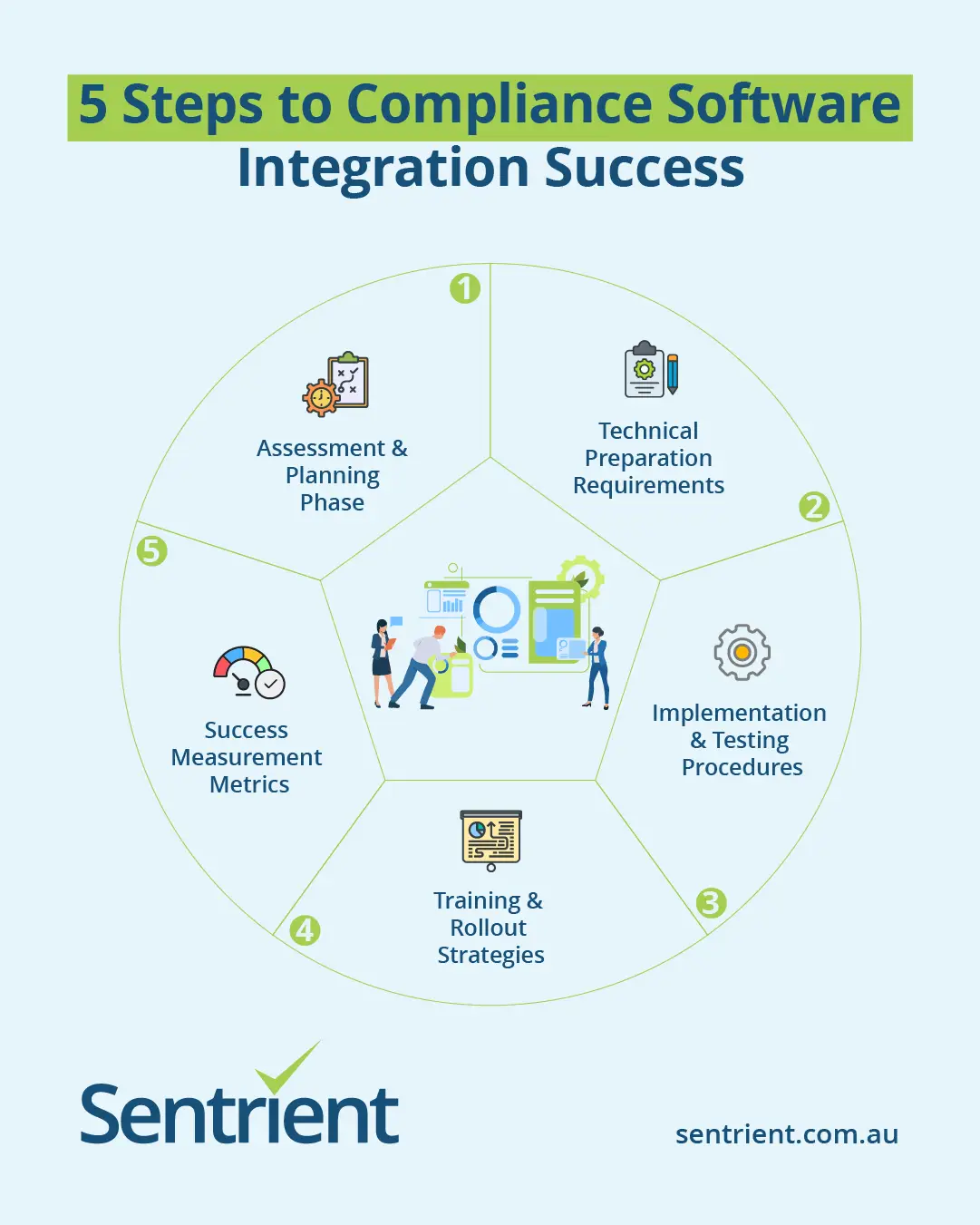Integrating compliance software with your existing business tools isn’t just a technical upgrade – it’s a strategic move that can transform how your organisation manages risk and maintains regulatory standards. Modern businesses typically use 5-10 different software platforms daily, from CRM systems to accounting tools.
When you integrate compliance software effectively, you eliminate data silos and create seamless workflows that save time and reduce human error. Companies that successfully integrate compliance software with existing systems report up to 40% reduction in compliance-related administrative tasks.
At Sentrient, we’ve helped over 600 Australian businesses streamline their compliance processes through smart integration strategies. Whether you’re running a small team or managing a large organisation, the right integration approach can make compliance feel effortless rather than burdensome.
The key lies in understanding your current environment and choosing integration methods that complement, rather than complicate, your existing workflows.
What’s Your Current Business Software Setup?
1. Assess Your Current Digital Environment
Before you integrate compliance software, you need a clear picture of your existing digital environment. Most Australian businesses operate with a mix of core systems that handle different aspects of their operations.
2. Identify Your Core Business Tools
Your typical business toolkit likely includes customer relationship management (CRM) software, human resources information systems (HRMS), enterprise resource planning (ERP) platforms, and accounting software. Each system contains valuable data that could enhance your compliance management when properly connected.
3. Document All Software Platforms
Document every software platform your team currently uses, including cloud-based tools, desktop applications, and mobile apps. Note which systems store employee data, customer information, financial records, and operational metrics.
4. Map Current Data Flow
Understanding data flow between these systems is crucial. Where does information currently move manually between platforms? These manual touchpoints represent opportunities for automation through compliance software integration.
Important Things to Consider Before Integration
1. Data Security Priority
Data security must be your top priority when planning any integration. Compliance software handles sensitive information about your business operations, employee records, and regulatory requirements. Ensure any integration maintains or enhances your current security standards.
2. Industry-Specific Compliance Requirements
Compliance requirements vary significantly across Australian industries. Healthcare providers face different regulations than construction companies. Your integration strategy should align with industry-specific compliance frameworks that govern your business.
3. User Adoption Challenges
User adoption challenges can derail even the most technically sound integration. Consider how the integration will affect daily workflows for different team members. Will it simplify their tasks or create additional complexity?
4. Budget and Hidden Costs
Budget considerations extend beyond initial integration costs. Factor in ongoing maintenance, training requirements, and potential system upgrades. Hidden costs often emerge during the integration process if not properly planned.
5. Scalability Planning
Scalability planning ensures your integration grows with your business. Choose integration approaches that can accommodate new team members, additional compliance requirements, and evolving business processes without requiring complete overhauls.
Types of Business Tools for Compliance Integration
1. Human Resources Management Systems (HRMS)
Human Resources Management Systems (HRMS) forms the backbone of most compliance integrations. These platforms already contain employee data, training records, and performance metrics that compliance software needs to function effectively.
2. Customer Relationship Management (CRM) Platforms
Customer Relationship Management (CRM) platforms hold valuable information about client interactions, service delivery records, and customer feedback that can inform compliance monitoring and risk assessment processes.
3. Enterprise Resource Planning (ERP) Systems
Enterprise Resource Planning (ERP) systems manage financial data, supply chain information, and operational metrics. Integration with compliance software enables automated risk monitoring and audit trail creation across all business functions.
4. Communication and Collaboration Tools
Communication and collaboration tools like Microsoft Teams, Slack, or SharePoint can be integrated to streamline compliance-related communications, document sharing, and approval workflows throughout your organisation.
Integration Methods and Approaches
1. Application Programming Interface (API) Integration
Application Programming Interface (API) integration offers the most robust connection between systems. APIs allow real-time data synchronisation and automated workflows that keep all platforms updated simultaneously without manual intervention.
2. Middleware Solutions
Middleware solutions act as translators between different software platforms. These tools are particularly useful when direct API integration isn’t available or when connecting legacy systems with modern compliance software.
3. Single Sign-On (SSO) Integration
Single Sign-On (SSO) integration simplifies user access across multiple platforms while maintaining security. SSO reduces password fatigue and ensures consistent access controls across all integrated systems.
4. Webhook Integration
Webhook integration enables event-triggered communications between systems. When specific actions occur in one platform, webhooks automatically notify other systems to update relevant information or trigger specific workflows.
5. File-Based Integration
File-based integration involves automated data exchange through structured files like CSV or XML. While less sophisticated than API integration, this method works well for batch updates and periodic data synchronisation.
6. Custom Integration Solutions
Custom integration solutions may be necessary for unique business requirements or legacy systems. These bespoke approaches require more development time but offer complete control over integration functionality.
Comparison of Integration Methods
| Integration Method | Implementation Time | Technical Complexity | Ongoing Maintenance | Best for |
|---|---|---|---|---|
| API Integration | 2-6 weeks | High | Low | Real-time data sync |
| Middleware | 3-8 weeks | Medium | Medium | Legacy system connections |
| SSO | 1-3 weeks | Low | Low | User access management |
| Webhooks | 1-4 weeks | Medium | Low | Event-triggered updates |
| File-based | 1-2 weeks | Low | Medium | Batch processing |
| Custom Solutions | 6-16 weeks | Very High | High | Unique requirements |
Step-by-Step Integration Process

1. Assessment and Planning Phase
Audit your current systems to identify integration opportunities and potential conflicts. Document data formats, user access levels, and existing workflow dependencies that could affect the integration process.
Define integration objectives clearly. What specific outcomes do you want to achieve? Common goals include reducing manual data entry, improving audit trail accuracy, and automating compliance monitoring tasks.
Map data relationships between systems to understand how information flows through your organisation. Identify which data elements need real-time synchronisation versus periodic updates.
2. Technical Preparation
Review API documentation for all systems involved in the integration. Understanding technical capabilities and limitations helps set realistic expectations and timeline estimates.
Establish data governance protocols to ensure consistency across integrated platforms. Define data ownership, update responsibilities, and conflict resolution procedures before integration begins.
Prepare backup and rollback procedures in case integration issues arise. Having clear recovery plans reduces risk and builds confidence in the integration process.
3. Implementation and Testing
Start with pilot integration between two systems before expanding to your full technology stack. This approach allows you to identify and resolve issues without affecting your entire operation.
Test data accuracy thoroughly during the integration process. Verify that information syncs correctly and that automated workflows function as expected under various scenarios.
Monitor system performance to ensure integration doesn’t negatively impact existing platform functionality or user experience across your organisation.
4. Training and Go-Live
Train team members on new workflows created by the integration. Focus on practical scenarios they’ll encounter in their daily work rather than technical details of how systems connect.
Implement gradual rollout to different departments or user groups. This staged approach allows you to address issues before they affect your entire organisation.
Common Integration Challenges and Solutions
1. Data Format Mismatches
Data format mismatches frequently occur when connecting systems that store information differently. One platform might use numerical codes while another uses text descriptions for the same data elements.
Solution: Implement data transformation rules that automatically convert information between formats during the synchronisation process. Modern integration platforms include built-in transformation capabilities for common data types.
2. Authentication and Access Control Conflicts
Authentication and access control conflicts can arise when systems have different security requirements or user permission structures.
Solution: Use SSO solutions combined with role-based access controls that maintain security standards while simplifying user management across integrated platforms.
3. Performance Degradation Issues
Performance degradation may occur if integration processes consume too many system resources or create excessive network traffic during peak usage periods.
Solution: Schedule resource-intensive synchronisation tasks during off-peak hours and implement incremental updates rather than full data transfers wherever possible.
4. Version Control Problems
Version control issues can emerge when different systems update shared data simultaneously, creating conflicts about which version represents the current state.
Solution: Establish clear data ownership rules and implement conflict resolution protocols that automatically determine authoritative data sources for different information types.
Best Practices for Successful Integration
1. Start Small and Scale Gradually
Start small and scale gradually rather than attempting to integrate all systems simultaneously. Begin with high-value, low-risk connections that deliver immediate benefits to build momentum and confidence.
2. Maintain Detailed Documentation
Maintain detailed documentation throughout the integration process. Document data mappings, workflow changes, and troubleshooting procedures to support ongoing maintenance and future enhancements.
3. Establish Monitoring and Alerting Systems
Establish monitoring and alerting systems to proactively identify integration issues before they affect business operations. Automated monitoring helps maintain system reliability and user confidence.
4. Regular Testing and Validation
Regular testing and validation ensures integration continues functioning correctly as systems receive updates and business requirements evolve over time.
5. User Feedback Collection
User feedback collection helps identify opportunities for improvement and ensures the integration continues meeting practical business needs rather than just technical requirements.
6. Security Review and Updates
Security review and updates should occur regularly to address new threats and ensure integrated systems maintain appropriate protection for sensitive compliance data.
Measuring Integration Success
1. Time Savings Metrics
Time savings metrics quantify how integration reduces manual tasks and administrative overhead. Track hours saved per week on compliance-related activities across different departments.
2. Data Accuracy Improvements
Data accuracy improvements measure reduction in errors caused by manual data entry or outdated information. Compare error rates before and after integration implementation.
3. User Satisfaction Scores
User satisfaction scores indicate whether integration genuinely improves daily workflows or creates additional complexity for team members using the systems.
4. Compliance Reporting Efficiency
Compliance reporting efficiency shows how integration affects your ability to generate accurate, timely reports for audits and regulatory requirements.
5. Cost-Benefit Analysis
Cost-benefit analysis compares integration investment against ongoing operational savings and risk reduction benefits over time.
Monitor these metrics regularly to demonstrate integration value and identify areas for further optimisation or expansion.
Future-Proofing Your Compliance Integration
1. Cloud-Native Solutions
Cloud-native solutions offer better scalability and integration capabilities than legacy on-premise systems. Consider migration strategies that position your organisation for future growth and technology advances.
2. API-First Platforms
API-first platforms provide more flexible integration options and easier connections with emerging business tools. Prioritise systems that offer robust API capabilities when making technology decisions.
3. Artificial Intelligence Integration
Artificial intelligence integration will increasingly automate compliance monitoring and risk assessment tasks. Choose platforms that can incorporate AI capabilities as they mature and become more accessible.
4. Regular Platform Evaluation
Regular platform evaluation ensures your integrated systems continue meeting evolving business requirements and regulatory changes affecting your industry.
Plan for periodic integration reviews to assess performance, identify improvement opportunities, and ensure your compliance technology stack remains current and effective.
Conclusion
Successfully integrating compliance software with existing business tools requires careful planning, gradual implementation, and ongoing attention to user needs. The investment in proper integration pays dividends through improved efficiency, reduced risk, and better regulatory compliance.
Sentrient’s integrated approach to HR, compliance, and GRC management system demonstrates how thoughtful integration can transform business operations. Ready to explore how integration could streamline your compliance processes? Contact our team for a personalised consultation today.
Frequently Asked Questions
1. How long does it typically take to integrate compliance software with existing business tools?
Integration timelines vary from 1-16 weeks depending on complexity and method chosen. API integrations typically take 2-6 weeks, while custom solutions may require 6-16 weeks for complete implementation.
2. What’s the most cost-effective way to integrate compliance software for small businesses?
Small businesses often benefit most from SSO integration and file-based synchronisation, which offer good functionality without requiring extensive technical resources or ongoing maintenance costs.
3. Can compliance software integrate with legacy systems that don’t have modern APIs?
Yes, middleware solutions and custom integration approaches can connect legacy systems with modern compliance platforms. These methods require more technical planning but provide effective integration paths.
4. How do we ensure data security during the integration process?
Implement encryption for all data transfers, use secure authentication methods, maintain access controls, and conduct security audits before and after integration completion.
5. What happens if integration fails or causes system conflicts?
Proper integration planning includes backup procedures and rollback capabilities. Start with pilot integrations and maintain detailed documentation to quickly resolve any issues that arise during implementation.





